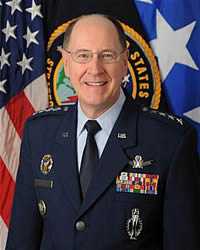STRATCOM Commander Rejects High Estimates for Chinese Nuclear Arsenal
 |
| STRATCOM Commander estimates that China has “several hundred” nuclear warheads. |
.
By Hans M. Kristensen
The commander of U.S. Strategic Command (STRATCOM) has rejected claims that China’s nuclear arsenal is much larger than commonly believed.
“I do not believe that China has hundreds or thousands more nuclear weapons than what the intelligence community has been saying, […] that the Chinese arsenal is in the range of several hundred” nuclear warheads.
General Kehler’s statement was made in an interview with a group of journalists during the Deterrence Symposium held in Omaha in early August (the transcript is not yet public, but was made available to me).
General Kehler’s statement comes at an important time because much higher estimates recently have created a lot of news media attention and are threatening to become “facts” on the Internet. A Georgetown University briefing last year hypothesized that the Chinese arsenal might include “as many as 3,000 nuclear warheads,” and General Victor Yesin, a former commander of Russia’s Strategic Rocket Forces, recently published an article on the Russian web site vpk-news in which he estimates that the Chinese nuclear weapons arsenal includes 1,600-1,800 nuclear warheads.
In contrast, Robert S. Norris and I have published estimates of the Chinese nuclear weapons inventory for years, and we currently set the arsenal at approximately 240 warheads. That estimate – based in part on statements from the U.S. intelligence community, fissile material production estimates, and our assessment of the composition of the Chinese nuclear arsenal – obviously comes with a lot of uncertainly and assumptions, but we’re pleased to see that it appears to fit with the “several hundred” warheads mentioned by General Kehler.
Like the other nuclear weapon states, China is modernizing its nuclear arsenal, but it is the only one of the five original nuclear powers (P-5) that appears to be increasing the size of its warhead inventory. That increase is modest and appears to be slower than the U.S. intelligence community projected a decade ago. Those who see an interest in exaggerating China’s nuclear developments thrive on secrecy, so it is important that China – and others who know – provide some basic information about trends and developments to avoid exaggerated estimates. The reality is bad enough as it is.
This publication was made possible by a grant from Carnegie Corporation of New York and Ploughshares Fund. The statements made and views expressed are solely the responsibility of the author.
Satellite imagery has long served as a tool for observing on-the-ground activity worldwide, and offers especially valuable insights into the operation, development, and physical features related to nuclear technology.
This report outlines a framework relying on “Cooperative Technical Means” for effective arms control verification based on remote sensing, avoiding on-site inspections but maintaining a level of transparency that allows for immediate detection of changes in nuclear posture or a significant build-up above agreed limits.
The grant comes from the Carnegie Corporation of New York (CCNY) to investigate, alongside The British American Security Information Council (BASIC), the associated impact on nuclear stability.
Satellite imagery of RAF Lakenheath reveals new construction of a security perimeter around ten protective aircraft shelters in the designated nuclear area, the latest measure in a series of upgrades as the base prepares for the ability to store U.S. nuclear weapons.